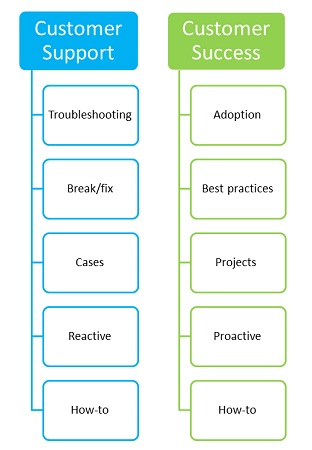Although the title says “aligning”, the most important thing in this particular subject might be “defining”. Because so many Customer Success organizations grow up in the Services part of the enterprise, this means they sit right alongside the Customer Support function. Nothing wrong with that in theory, but in practice the differences can often be confusing. That problem is exacerbated in situations where Customer Success is viewed, or, worse yet, created as an extension of Customer Support.
If the two organizations are not clearly defined and differentiated, they will either meld together in an unhealthy way or everyone involved will simply be confused, including your customers. This is obviously not a good thing so let’s set out to see if we can adequately define both of these critical organizations.
Customer Support has been around forever so let’s start there. They are typically defined as the group that does “break/fix” and are often characterized as always-on-call and the people behind the 800 number. That’s all well and good but it doesn’t necessarily help your customer or internal folks to whom this doesn’t matter.
“Break/fix” doesn’t necessarily mean a lot to a customer although it does get at one of the key elements involved with Customer Support – something appears to be broken. Customers call Support when it looks like something is broken. Error codes appear, logins don’t work, web pages are down, reports don’t run. Those are some of the obvious types of symptoms that lead customers to Support. There are some gray areas, too, but more on that later.
Now let’s look at some of the obvious times for a customer to interact with Customer Success. At its core, Customer Success is about two things:
- Customer experience
- Product adoption
When we say “customer experience,” we’re talking about anything that makes a customer’s life more difficult. An incorrect invoice would be a good example. Or, a training class that did not deliver on its promise. Or, an onboarding process that did not prepare the customer for success.
This is not to say that a customer can’t, or won’t, call Customer Support for any of these things, too. But, as you build a fully functioning Customer Success organization, they will usually be better equipped to handle these kinds of issues. Plus, because they are usually measured and incented on renewals/retention, they will be empowered to influence other organizations (including Support) in a positive way to better serve your customers.
The second focus of Customer Success is product adoption. This is very different from a break/fix mentality. This is about engaging with customers to ensure that the ROI for your products is being realized. Customer Support pays no attention to, and has no responsibility for, customers who are not fully utilizing your products. Customer Support is largely a reactive organization while Customer Success strives to be a proactive organization.
In an ideal world, Customer Success is actively monitoring customer health and reaching out to customers who appear to be at-risk. There are many indicators of at-risk and they can vary from company to company, but some of the more obvious ones include negative usage trends, poor survey scores, # of Customer Support calls, and invoice history. A healthy Customer Success organization is monitoring these metrics and intervening accordingly. The result of this analysis is often a project designed to bring a specific customer back to full health.
Let’s take a very common example. A healthy, happy customer has a power user of your product who leaves the company. This is always a red flag and often requires a significant time investment to bring a new person up to speed to fill the shoes of the previous power user. This process could take several weeks and is a classic case for Customer Success. Nothing is broken. No error codes are being seen. But the customer needs help or they will likely churn, and it is a project to make them whole again.
Here are a few key words that can help differentiate Support and Success:

Oops. You probably noticed that “how-to” appears on both lists. This is a big part of the gray area you’ll encounter. It really is appropriate for both organizations to handle some of these types of questions. This will also motivate both orgs to provide a knowledgebase that will deflect many of these requests. In the long run, a large portion of how-to questions should be handled by your knowledgebase, not by your people.
The metrics for measuring each org are another way to clearly differentiate. Customer Support is typically measured on clear SLAs – time to respond, time to close, # of cases handled per day/week/month/CSR. Customer Success is ultimately measured on retention and, in some cases, on upsell as well.
Now we finally get to the alignment part of the discussion. Once the definition of each organization is clear, the alignment becomes very easy. A high degree of collaboration is required so that each party knows what the other is up to inside a particular customer. And “cases” are often shared between them, too. It will not be uncommon for Support to introduce customers to their CSM for help and it will be equally common for Customer Success to open a Support case on behalf of a customer.
Doing these handoffs well is a key part of making the overall customer experience a positive one. There’s no substitute for good communication but this is where a true 360 view of your customer will bring huge value. If both singers are reading from the same songbook, there really is a chance for harmony. Without this, the bar is raised much higher for more meetings, consistent reports, two-way communication, and other activities that will ultimately break down.
In future blogs, we’ll explore how the collaboration and definition of these two organizations changes when a Premier Support option is offered to customers or when Technical Account Managers (TAMs) are introduced into the equation. But, for today, I hope the above helps you define the differences between Support and Success, which will make the alignment much easier. Your customers will be the beneficiaries.

